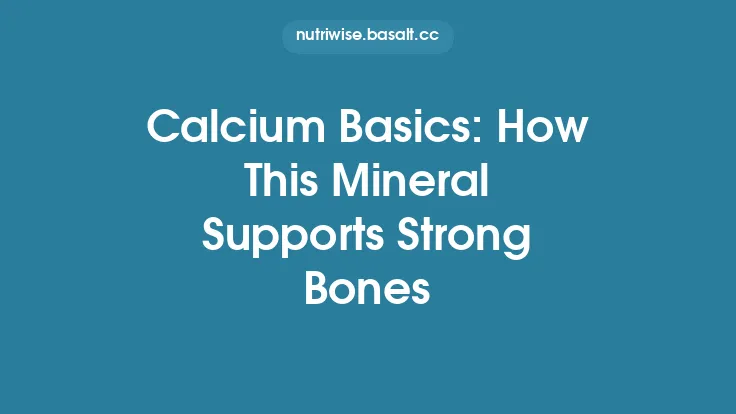Vitamin D is a fat‑soluble micronutrient that plays a pivotal role in maintaining skeletal integrity. While many people recognize its connection to bone health, the underlying mechanisms and practical considerations often remain unclear. This article unpacks the essential concepts behind vitamin D’s contribution to strong bones, offering a comprehensive, evergreen reference for anyone interested in the science of bone nutrition.
Understanding Vitamin D: Forms and Metabolism
Vitamin D exists primarily in two natural forms: vitamin D₃ (cholecalciferol) and vitamin D₂ (ergocalciferol). Both are biologically inactive until they undergo a two‑step hydroxylation process. The first hydroxylation occurs in the liver, converting the parent compound into 25‑hydroxyvitamin D [25(OH)D], the major circulating form and the standard marker for assessing vitamin D status. The second hydroxylation takes place mainly in the kidneys, producing the hormonally active metabolite 1,25‑dihydroxyvitamin D [1,25(OH)₂D], also known as calcitriol.
Calcitriol functions as a steroid hormone, binding to the vitamin D receptor (VDR) present in numerous cell types, including those of the intestinal epithelium, bone, kidney, and parathyroid gland. This receptor‑mediated signaling cascade is the cornerstone of vitamin D’s influence on calcium balance and bone remodeling.
Vitamin D’s Role in Calcium Homeostasis
Calcium is the primary mineral component of bone, and its systemic regulation is tightly coordinated by vitamin D, parathyroid hormone (PTH), and calcitonin. When dietary calcium intake is insufficient, calcitriol enhances intestinal calcium absorption by upregulating the expression of calcium‑transport proteins such as TRPV6 (transient receptor potential vanilloid type 6) and calbindin‑D₉k. This increase in absorption helps maintain serum calcium concentrations within a narrow physiological range.
In parallel, calcitriol modulates renal calcium reabsorption, reducing urinary calcium loss. By acting on the distal tubules of the nephron, it promotes the expression of calcium channels and transporters that reclaim calcium from the filtrate. Together, these actions ensure that adequate calcium is available for bone mineralization, even when dietary sources fluctuate.
Impact on Bone Remodeling and Strength
Bone is a dynamic tissue that undergoes continuous remodeling through the coordinated activity of osteoblasts (bone‑forming cells) and osteoclasts (bone‑resorbing cells). Vitamin D influences both arms of this process:
- Osteoblast Stimulation: Calcitriol binds to VDRs on osteoblast precursors, promoting their differentiation and enhancing the production of osteocalcin, a non‑collagenous protein essential for matrix mineralization. This activity supports the deposition of hydroxyapatite crystals, the mineral phase that confers rigidity to bone.
- Osteoclast Regulation: While vitamin D does not directly create osteoclasts, it indirectly facilitates bone resorption by stimulating the expression of receptor activator of nuclear factor κB ligand (RANKL) on osteoblasts and stromal cells. RANKL binds to its receptor RANK on osteoclast precursors, driving their maturation. This controlled resorption is necessary for the removal of micro‑damage and the renewal of bone tissue.
The net effect of vitamin D on bone remodeling is a balanced turnover that preserves structural integrity. Inadequate vitamin D disrupts this equilibrium, leading to reduced mineralization (osteomalacia) in adults and impaired bone growth (rickets) in children.
Factors Influencing Vitamin D Status
Several physiological and environmental variables affect how much vitamin D the body can produce and retain:
- Skin Pigmentation: Melanin absorbs ultraviolet B (UVB) radiation, reducing the cutaneous synthesis of vitamin D₃. Individuals with darker skin may require longer exposure periods to achieve comparable vitamin D production.
- Age: The capacity of the skin to generate vitamin D declines with age due to reduced 7‑dehydrocholesterol content. Additionally, renal conversion to calcitriol becomes less efficient in older adults.
- Body Composition: Vitamin D is sequestered in adipose tissue, which can lower its bioavailability in individuals with higher body fat percentages.
- Renal Function: Since the kidneys are the primary site for the final activation step, chronic kidney disease can impair calcitriol synthesis, necessitating careful monitoring.
- Medications and Health Conditions: Certain drugs (e.g., glucocorticoids, anticonvulsants) and disorders (e.g., malabsorption syndromes, liver disease) can interfere with vitamin D metabolism.
Understanding these determinants helps explain why vitamin D status can vary widely across populations, even when environmental exposure appears similar.
Identifying and Addressing Deficiency
Clinically, vitamin D deficiency is most often recognized through measurement of serum 25(OH)D concentrations. While specific thresholds are subject to ongoing debate, consistently low values are associated with:
- Bone Pain and Muscle Weakness: Suboptimal calcium absorption can lead to secondary hyperparathyroidism, causing demineralization and musculoskeletal discomfort.
- Increased Fracture Risk: Reduced bone mineral density (BMD) and compromised microarchitecture elevate susceptibility to fractures, particularly in weight‑bearing bones.
- Radiographic Signs: In severe cases, imaging may reveal Looser’s zones (pseudofractures) indicative of osteomalacia.
When deficiency is suspected, a comprehensive assessment should include evaluation of dietary intake, sun exposure habits, medical history, and potential drug interactions. Addressing the underlying cause—whether it be limited UVB exposure, malabsorption, or renal impairment—is essential for restoring optimal bone health.
Interplay with Other Micronutrients
Vitamin D does not act in isolation; its effectiveness is amplified by synergistic relationships with other nutrients:
- Calcium: Adequate calcium intake is a prerequisite for vitamin D to exert its full effect on bone mineralization. Without sufficient calcium, increased absorption driven by vitamin D cannot translate into stronger bone.
- Magnesium: This mineral serves as a cofactor for the enzymes that hydroxylate vitamin D in the liver and kidneys. Magnesium deficiency can therefore blunt the activation of vitamin D.
- Phosphorus: Together with calcium, phosphorus forms the hydroxyapatite lattice. Vitamin D helps regulate phosphorus absorption, ensuring the proper stoichiometric balance for mineral deposition.
- Vitamin K2: Emerging evidence suggests that vitamin K2 works alongside vitamin D to direct calcium to the bone matrix and away from soft tissues, supporting optimal mineralization.
A holistic approach that considers these interdependencies yields a more robust strategy for maintaining skeletal health.
Practical Guidance for Maintaining Healthy Bones
While the article avoids prescribing specific supplementation regimens, several general practices can help sustain adequate vitamin D levels and, by extension, bone strength:
- Balanced Sun Exposure: Regular, moderate exposure of uncovered skin to natural sunlight during mid‑day hours can support cutaneous vitamin D synthesis. Individuals should tailor exposure to their skin type, geographic location, and lifestyle, while also observing skin‑cancer‑preventive measures.
- Consistent Dietary Patterns: Incorporating foods naturally containing vitamin D, as well as fortified products, contributes to overall status. Pairing these foods with calcium‑rich options enhances absorption efficiency.
- Regular Physical Activity: Weight‑bearing and resistance exercises stimulate bone formation and improve mineral density. Mechanical loading also promotes the release of growth factors that work synergistically with vitamin D‑mediated pathways.
- Routine Health Checks: Periodic assessment of serum 25(OH)D, especially for at‑risk groups (e.g., older adults, individuals with limited sun exposure, those with chronic illnesses), enables early detection of insufficiency.
- Lifestyle Optimization: Managing body weight, limiting excessive alcohol consumption, and avoiding smoking are all supportive of both vitamin D metabolism and overall bone health.
By integrating these habits into daily life, individuals can create an environment that naturally supports the vitamin D–calcium axis essential for robust skeletal architecture.
Monitoring and When to Seek Professional Advice
Even with diligent self‑care, certain circumstances warrant professional evaluation:
- Persistent bone pain, unexplained fractures, or muscle weakness.
- Chronic conditions affecting the liver, kidneys, or gastrointestinal tract.
- Use of medications known to interfere with vitamin D metabolism.
- Unexplained changes in serum calcium or phosphate levels.
Healthcare providers can order targeted laboratory tests, interpret results in the context of overall health, and recommend personalized interventions—whether that involves adjusting lifestyle factors, addressing underlying medical issues, or, when appropriate, prescribing vitamin D analogs.
Future Directions in Vitamin D Research
The scientific community continues to explore nuanced aspects of vitamin D biology that may refine our understanding of bone health:
- Genetic Polymorphisms: Variations in genes encoding VDR, enzymes involved in vitamin D metabolism, and transport proteins may influence individual responsiveness to vitamin D and susceptibility to bone disorders.
- Non‑Classical Actions: Beyond calcium regulation, vitamin D exerts immunomodulatory and anti‑inflammatory effects that could indirectly affect bone remodeling, especially in conditions like rheumatoid arthritis.
- Novel Analogs: Research into synthetic vitamin D analogs aims to maximize bone‑protective benefits while minimizing hypercalcemic risk, offering potential therapeutic avenues for patients with complex metabolic profiles.
- Microbiome Interactions: Emerging data suggest that gut microbiota composition may impact vitamin D absorption and metabolism, opening a new frontier for integrative bone health strategies.
Staying abreast of these developments will enable clinicians and nutrition professionals to incorporate cutting‑edge insights into practice, ensuring that recommendations remain evidence‑based and effective.
In summary, vitamin D serves as a linchpin in the intricate network that sustains bone strength. By facilitating calcium absorption, regulating renal reabsorption, and orchestrating the activities of bone‑forming and bone‑resorbing cells, it underpins the continual renewal of skeletal tissue. Recognizing the factors that influence vitamin D status, appreciating its synergy with other nutrients, and adopting lifestyle practices that support its natural production are all essential steps toward lifelong bone health.





